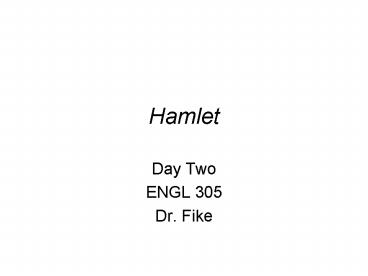Hamlet PowerPoint PPT Presentation
Title: Hamlet
1
Hamlet
- Day Two
- ENGL 305
- Dr. Fike
2
Outlines
- MLA formatget straight on this.
- WC listone continuous list, not primary and
secondary lists. - Every paper should have a review of criticism.
- You must have at least 5 critical sources
(criticism on your play). - You need to learn how to write a research paper.
- Go to the Writing Center.
- Have a conference with me.
- Do another draft of your outline.
- Apply the elements of critical thinking, as I
have modeled below in this presentation.
3
Group Activity
- Passages 1.2.129ff., 2.2.549ff., and 3.1.56ff.
- You will start with one soliloquy and rotate
twice so that you talk about all three. - First station Generate questions about the
soliloquy that you have been assigned. Write
your questions on the board (or big sheets of
paper). - Second station Respond to the questions left by
the previous group. Write your answers on the
board (or big sheets). - Third station Respond to the answers left by
the previous group. Write your responses as
before. Then appoint one person to present the
content of the written material at your third
station to the rest of the class.
4
Large-Group Discussion
- What did you learn about your soliloquy?
5
A Traditional Perspective on Revenge
- 4.5.134ff. To hell, allegiance! Vows, to the
blackest devil! / Conscience and grace, to the
profoundest pit! / I dare damnation. To this
point I stand, / That both the worlds I give to
negligence, / Let come what comes, only Ill be
revenged / Most throughly for my father. - 4.7.127 Laertes wants To cut his Hamlets
throat i the church. - 4.7.129 The king says, Revenge should have no
bounds.
6
POINT
- What unifies all three soliloquies is Hamlets
theological perspective he thinks about the
relationship between his actions and the
afterlife.
7
To be or not to be, etc.
- For a detailed analysis of Hamlets To be or not
to be soliloquy, see the next slides from my
article Thinking in a Discipline An Assignment
in Critical Thinking Class, The CEA Forum 36.2
(2007). - If time remains (or on your own), apply the
elements of critical thinking to this speech.
8
To be or not to be via the Elements from CRTW
201
- The context is a murder mystery in which Hamlet
is planning, at this moment, to trick Claudius
into revealing his guilt with the help of the
players. - The point of view is that of a young man whose
psychomachia (soul struggle) involves competing
imperatives such as mother and father, reason and
emotion, duty and caution, scholar and warrior,
womanliness and what a critic calls tough,
fatalistic cool (Rogers-Gardner 35) and whose
psyche is beset by melancholy, acedia, and
depersonalization (that is, a disconnection from
his feminine side).
9
More
- The question at issue is not the one that Hamlet
himself asks Why would one stay in this life
and put up with fardels (burdens) when suicide
is an option? Nor is it the question that
students often assume it to be namely, should
Hamlet kill himself? It is instead a more
general question that is not directly stated
What course of action should one take in the
face of worldly obstacles? In other words, as
the absence of the pronoun I indicates, the
question is less personal and practical than it
is general and philosophical.
10
Still More
- His purpose, then, is to analyze the options or
alternatives, which are these endure passively,
confront actively, or commit suicide. In
exploring these alternatives, Hamlet has some
information to go on everyone ages, rulers
oppress, the prideful insult, love stinks, law is
slow, administrators suck, and merit does not
always mean advancement.
11
More Elements
- Although he assumes that he cannot tell the
nature of the afterlife, the passage identifies
competing alternatives when we shuffle off our
mortal coil, as a snake sheds its skin, the
resulting state may be the end of individual
consciousness or a state in which dreams may be
more problematic than the worldly troubles left
behind. If, as Hamlet mentions in a previous
passage, God has fixed / His canon gainst
self-slaughter (1.2.132-33), then the
implication and consequence of suicide would be
damnation, which is also a key concept in
Hamlets soliloquy, along with conscience and
sin.
12
Final Slide
- His conclusionand here he finally switches from
third person singular to first person plural,
presumably in order to include himselfis that
thought, by which he means over-analysis,
prevents a thinking person from taking his own
life or taking arms against his sea of
troubles. The soliloquy ends with this
statement to Ophelia, which Hamlet probably says
under his breath Nymph, in thy orisons / Be
all my sins remembered, which implies his own
Claudius-like inability to pray.
END

